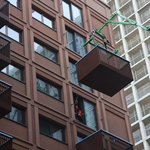I have great concerns that GO will not be able to break habits and will continue to focus on the long distance commuter, as they have for almost 50 years. They probably would like a nodal hub between GO and each subway line, but not much in the way of infill stations beyond that.
I think GO is in the commuter mindset right now because they're running really long diesel trains, which would make it hard to build infill stops without really affecting service. However, when you're using shorter electrified trains with a faster acceleration and deceleration, the possibility of implementing infill stops drastically increases, especially if these stops are to be located in good locations for integration with local transit systems (ex: new stop at Eglinton on the Barrie line to create a transfer with the Crosstown LRT).
I have also described a in a couple places on UT a system by which GO can serve both 905 and 416 commuters, using 3 route patterns on all lines during rush hour.
Would LRT have enough capacity? To run on surface (Don Mills) north of Eglinton, they would have to run 2 car trains. This would greatly reduce capacity as only 2 car trains would be traversing Queen. They would also have to entertain interlining or branching, which based on earlier comments in this post and the attitude of the TTC, is quite operationally difficult.
You can probably get 3 car train sets on Don Mills and Jane. Also, there's the possibility of short-turning longer train sets at Eglinton or Bloor-Danforth. The DRL is projected to be 17,500 peak hour, which is in the upper range of LRT, but still within it, especially when it's tunnelled. Ottawa's LRT is projected to hit 24,000 pphpd by 2031.
Using the DRL's projected peak usage, and 3 car train sets at crush load, you'd need 1 train every 2 minutes during peak to meet that demand. Run 3 car train sets at 1.5 min intervals and you're golden. You can have some of those short turn so they don't overload the at-grade sections further north.
If the DRL is a true HRT subway, it should have several LRT's at the terminal. At Science Centre, this would be Don Mills and Eglinton. On the West, as is stated, there could be several options depending on whether the termination is Dundas/Bloor, Eglinton/Jane, or Queen/Roncesvalles.
If the HRT subway ends at only one LRT line, it would be too similar to the Danforth to SRT interchange which basically just adds a transfer to almost all passengers.
I'm generally not a fan of linear transfers, especially when they're permanent like an LRT to HRT transfer. If it's something like a BRT to HRT transfer (for example, VIVA into Finch Station), I'm more accepting of it, because I know that the BRT is not meant as a permanent solution. The only place I'm ok with linear transfers is at major transportation hubs (ex: RHC or STC).
If LRT can handle the peak capacity of the line (and I do stress if, because in some cases it can't), and is more suitable for extension further out in the suburbs, I say go with that. Switching technologies halfway through a corridor I think should generally be avoided.




